#clinton heylin
Explore tagged Tumblr posts
Text
New books: Essay in Bob Dylan: Mixing Up the Medicine, mentions in books by Jesse Rifkin and Sasha Frere-Jones

The new 600-page catalog of the Bob Dylan Archive in Tulsa, titled Bob Dylan: Mixing Up the Medicine, contains an essay by me about Dylan's relationship to improvisation, inspired by an outtake from the 1976 Hard Rain TV special of "Tangled Up in Blue." In addition to scads of illustrations of the archive's holding, the book also has essays from Lee Ranaldo, Richard Hell, Ed Ruscha, John Doe, Greg Tate, Alex Ross, Greil Marcus, Lucy Sante, Michael Ondaatje, Clinton Heylin, and many others. Much appreciation to editor Mark Davidson, and to Michael Chaiken, who commissioned the piece and brought me to Tulsa to spend time at the archive. More info here.
In other book news, I was interviewed fairly extensively about working at Tonic, the now-defunct Lower East Side music club, by Jesse Rifkin for his book This Must Be the Place: Music, Community, and Vanished Spaces in New York City. And my friend Sasha Frere-Jones has some nice things to say about a short-lived band we had together in the late 90s in his memoir, Earlier.
#bob dylan#bobdylancenter#leeranaldo#richard hell#ed ruscha#greg tate#Greil Marcus#Lucy sante#michael ondaatje#clinton heylin#Jesse rifkin#Sasha frère-jones
3 notes
·
View notes
Text
I SHALL BE RELEASED
When Bob Dylan in 1967 recorded I Shall Be Released in the basement of the Big Pink, a house rented by Rick Danko close to Woodstock, the title was elegiac and had a double meaning, naturally. The previous summer, on the night of 29 July 1966, Bob almost faced his maker when he skidded off the road on route 212 and crashed the 500cc Triumph Tiger that had taken him across America to see more of…

View On WordPress
0 notes
Text

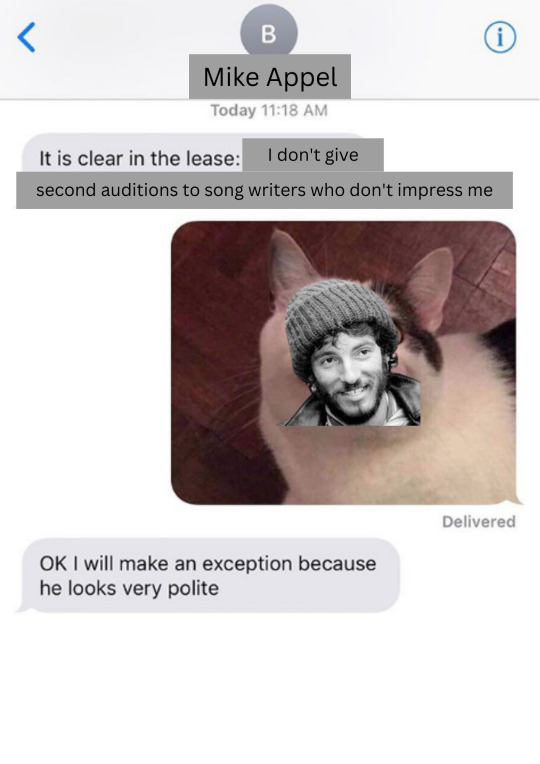
For months now I have been making silly little Bruce Springsteen memes to send to my wife and I think it's time I start releasing them into the world.
#if anyone is curious her response to this was “all the best memes come with background reading”#because i also had to explain to her who mike appel is before i could send her the meme#bruce springsteen#excerpt is from clinton heylin's book about bruce#backstreets posting
39 notes
·
View notes
Text
Kat Stratford Inspired Reads

The Bell Jar by Sylvia Plath
Not Here To Be Liked by Michelle Quach
Bad Feminist by Roxanne Gay
Girls To The Front by Sara Marcus
Grunge Is Dead by Greg Pato
The Yellow Wallpaper by Charlotte Perkins Gilman
Taming Of The Shrew by William Shakespeare
This Woman's Work by Sinead Gleeson and Kim Gordon
Ariel by Sylvia Plath
The Girl With The Louding Voice by Abi Dare
The Second Sex by Simone de Beauvoir
Babylon's Burning: From Punk To Grunge by Clinton Heylin
Moxie by Jennifer Matthieu
Daisy Jones and The Six by Taylor Jenkins Reid
#books#book blog#10 things i hate about you#kat stratford#katarina stratford#julia stiles#booklr#readblr#book reccs#book recommendations#bookaddict#feminist#feminist books#music books#book list#kat stratford reads#sylvia plath#riot grrrl#riot ghoul#feminist recommendation
276 notes
·
View notes
Text
my vinyl records as marauders:
up your alley by joan jett & the blackhearts- marlene mckinnon
mindsets by joan jett & the blackhearts, rsd black friday exclusive- alecto carrow
i love rock n roll by joan jett & the blackhearts- lily evans
stuff from by brain/my brain after therapy by noahfinnce, double ep- peter pettigrew
saviors by green day- dorcas meadowes
sistahs by big joanie, silver vinyl- mary macdonald
debut album by rolling stones, rsd 2024 exclusive- florence
a day at the races by queen- sirius black
debut album by queen- peter pettigrew
greatest hits of queen- benjy fenwick
diamond dogs by bowie, half speed master- mulciber
rise and fall of ziggy stardust and the spiders from mars by david bowie- lily evans
debut album by david bowie- frank longbottom
electric warrior by t.rex- sirius black
singles going steady by buzzcocks, 45th anniversary edition/half speed master & essay by clinton heylin- james potter
london calling by the clash- caradoc dearborn
faster than the speed of light by bonnie tyler- pandora lovegood
debut album of led zeppelin- remus lupin
greatest hits of suzi quatro- alice fortescue
quatro by suzi quatro- davey gudgeon
transformer by lou reed- barty crouch jr
midnights by taylor swift, moonstone blue edition- andromeda black
piece of mind by iron maiden- emmeline vance
nevermind by nirvana- evan rosier
sound effects death & horror vol. 13- bellatrix black
black velvet by alannah myles, single 7 inch- narcissa black
#apologies if i used someone more than once#may have accidentally done some and then some i just couldn't budge. they're sooo more than once and i couldn't choose#marauders era
14 notes
·
View notes
Text
Actual facts from wikipedia about Bob Dylan making the album Empire Burlesque

When the tour was over, Dylan returned to New York and began work on his next studio album. As Clinton Heylin reports, Dylan recorded in sporadic sessions, as had become his norm, rather than "block-booking studio time" and recording in one concentrated period. The result was "an unprecedented expenditure of" time for recording a Dylan album, from July 1984 to March 1985 (although The Freewheelin' Bob Dylan had been recorded over a similarly long period).
To accommodate the casual nature of this process, Dylan chose to produce the sessions himself. Arthur Baker, who had previously worked with New Order and Afrika Bambaataa, was later recruited for these sessions, but much of the production work would actually be Dylan's.
One of his first decisions was to forgo the use of a stable set of musicians. Instead, Dylan recorded with an eclectic mix of studio professionals.
Wood later described his surprise at Dylan's lack of authority during the mixing process. "[The engineers would] say, 'Hey Bob, we don't need this,' and he'd say, 'Oh, okay.' And they'd make a mix to their ears, and he'd just stand outside and let them do it. And I'd be saying, 'Hey! You can't let these guys…Look!! They've left off the background vocals!' or 'What about the drums?!' But there would be something going on in the back of his head which didn't allow him to interfere. And yet if he'd have gone into the control room with the dominance that he had while we were cutting the stuff, it could have been mind-bending."
In terms of his own album, the New York sessions had so far been fairly unproductive. After six months of work, Dylan had only a few recordings that were deemed acceptable, and only two of these would eventually appear on Empire Burlesque.
"Sometimes nothing comes out, and other times I get a lot of stuff that I keep," Dylan said at the time. "I just put down the songs that I felt as I wanted to put them down. Then I'd listen and decide if I liked them. And if I didn't like them I'd either rerecord them or change something about them."
Some further overdubbing was scheduled, but with recording essentially finished, Arthur Baker was left to mix the album.
"I'm not too experienced at having records sound good," said Dylan. "I don't know how to go about doing that. With Arthur Baker...I just went out and recorded a bunch of stuff all over the place, and then when it was time to put this record together, I brought it all to him and he made it sound like a record."
A number of critics have noted the bizarre sources of inspiration behind some of the songs. As mentioned, some lines were lifted from old Humphrey Bogart pictures, but at least a few were taken from the sci-fi television show Star Trek. Author Clinton Heylin wrote that "one of the best couplets—'I'll go along with the charade / Until I can think my way out' (from "Tight Connection to My Heart")—actually comes verbatim from a Star Trek episode, 'Squire of Gothos'."
4 notes
·
View notes
Text












THE RECORDCHANGER YEAR-END EDITION 2024
My annual year-end review of my favorite records and books.
TOP NEW RELEASES
1. The Tortured Poets Department: The Anthology – Taylor Swift
2. TexiCali – Dave Alvin & Jimmie Dale Gilmore
3. The Border – Willie Nelson
4. Sensual – Rachel Z
5. Heaven (EP) – Softcult
6. The Lost Record – Susanna Hoffs
7. Short N’ Sweet – Sabrina Carpenter
8. Smoke and Fiction – X
9. =1 – Deep Purple
10. MoonDial – Pat Metheny
11. Memories Have Faces – The Loons
12. Brasil – Lee Ritenour & Dave Grusin
13. The Vienna Recital – Yuja Wang
14. Viva – Lone Justice
15. Hit Me Hard and Soft – Billie Eilish
REISSUES / ARCHIVE RELEASES
1. Woodstock 1969 – Ten Years After
2. The Best of Rory Gallagher at the BBC
3. Welcome to Shepherd’s Bush – The Rolling Stones
4. Live at The Wiltern – The Rolling Stones
5. Live at Fillmore East, 1969 – Crosby, Stills, Nash & Young
6. Live Through the Past, Darkly – The Dream Syndicate
7. Miles ’54 – Miles Davis
8. Brooklyn, NY 2011 – Sonic Youth
ARTIST OF THE YEAR
Taylor Swift
FINDS OF THE YEAR
Folklore; Red; Speak Now; Fearless; Evermore; Midnights – Taylor Swift
Norman Fucking Rockwell; Born to Die: The Paradise Edition; Ultraviolence; Did You Know That There’s a Tunnel Under Ocean Boulevard – Lana Del Rey
John Adams: Must the Devil Have All the Good Tunes? – Yuja Wang with the Los AngelesPhilharmonic
NVM; Lost Time; This Mess Is a Place – Tacocat
All Hands on The Bad One – Sleater-Kinney
Holly & the Italians – Holly Beth Vincent
Out of the Mist – Illusion
Back to Black – Amy Winehouse
Siren – Roxy Music
Children of the Future; Brave New World; Your Saving Grace; Number 5; Rock Love; Recall the Beginning…Journey to Eden – Steve Miller Band
Sheet Music – 10cc
Happy Nightmare Baby – Opal
Ask the Ages – Sonny Sharrock
Room of One’s Own; Under the Milky Way Express – Rachel Z
Bright Lights; The Deep End – Susanna Hoffs
At Home – Shocking Blue
BEST BOOKS OF THE YEAR
The Penguin Book of Rock & Roll Writing edited by Clinton Heylin (1992)
Just Backdated by Chris Charlesworth (2024)
Zip It Up! The Best of Trouser Press by Ira Robbins (2024)
THE YEAR IN REVIEW
This was the year where I finally accepted the inevitability of listening to music more often on digital files through a computer, rather than through a stereo system with a turntable, CD, and cassette player. My stereo got less use this year than any year since I began listening to music, but I listened to far more music than any year since I left the music retailing business. I made the transition out of convenience, and out of financial necessity. I have been priced out of buying physical media when it comes to music. I bought some things, of course, but very little after July. Prices on records, compact discs, and even cassettes just continued to rise. Delivery got more expensive, and less reliable. And availability fell to an all-time low. Everyone else can do as they please. But I will not overpay for anything. And I will not spend hours or days chasing what I want to buy – new or old. If the musician or the label can’t give me access to the music without hassle, and at a reasonable price, then it’s no sale. Plenty of music can be accessed, and listened to, and even owned digitally without any hassles, and, in some cases, even owned without having to pay. I’ve never been reluctant to buy what I wanted, but I simply refuse to be robbed, and I will not jump through hoops to find what I’m looking for. Looking at titles that were added to my collection this year, I only bought a single vinyl record in 2024, and not one cassette. I bought 29 compact discs, and 5 digital downloads. But I added many more titles to my digital collection this year at no cost. Most of those were titles I could not find a physical copy of anywhere. Some were available at prices that were outrageous. Still others were unavailable to me through regular channels. I was forced to improvise, and that’s what I did.
I spent a lot of time on You Tube listening to albums, and even more time with what is called The Vinyl Community. That’s a group of music lovers who upload videos to You Tube where they discuss what they own, what they’re buying, what they like and don’t like. That was in Spring, but before Spring turned to Summer, the novelty had worn off for me. There are still a few channels I follow, but I don’t fit in as a part of this “community.” Most of these collectors have a passion for music, but making videos for You Tube is a side business for them, and because they have a following, record labels and musicians often send them free copies of new releases hoping for favorable reviews, and, consequently, free or cheap advertising as a result. That business model calls into question the integrity of their opinions which, to my way of thinking renders them useless.
In any case, I’d hoped that my involvement as a viewer with that group would fill the gap that’s existed since I left the record business, as I no longer had a way of interacting with people who came into my shops and wanted to talk music, and exchange opinions. And while there are four or five of these people whose work I do enjoy, it’s clear I don’t belong there. They don’t respond to comments or questions you might ask, so it’s not dissimilar to being back on Facebook again where even your friends and family ignore you. I’d rather talk to myself on Tumblr.
You Tube did give me the opportunity to hear a lot of new releases this year that might otherwise have slipped past me. My lists would look very different, and would be much shorter if not for You Tube. So, the experience with the channel overall was certainly a good one.
As for the lists above, it turned out to be a pretty good year for music. I’ve already posted pieces about Taylor Swift, and Lana Del Rey, and they were the artists I listened to most in 2024. My choice of Taylor as Artist of the Year was easy. It wasn’t even close. She made the best record by far. She had the year’s biggest tour. She got written about, and photographed more than anyone else. And she deserved every accolade, and award she got. She’s the best, and most talented artist to debut this century, and I will listen to her music until my ears fall off. The Tortured Poets Society: The Anthology already cracked my all-time Top 200 Albums list when I revised it this summer. No album has ever done that in the year of release. And when I revise the list again, I would expect the album to move into the Top 100, and pull three or four of her older albums onto the list, too. Lana Del Rey will probably make the list as well, and maybe more than once.
Several of the artists who made my Top New Releases list have never made the list before. Rachel Z released her first album, Sensual, in 15 years, and it might be her best. Softcult’s 6 track EP, Heaven was one I listened to again and again. Sabrina Carpenter’s Short N’ Sweet jumped seven places on my list after I saw her Tiny Desk Concert last week for NPR. She’s far more talented than I realized on first listen. Even Billie Eilish slipped onto the list this year. First time I’ve actually taken the time to listen to her, and I was impressed. But the old guard was well-represented by Dave Alvin and Jimmie Dale Gilmore whose TexiCali would’ve been an easy number one had Taylor Swift taken the year off. Willie Nelson released The Border, his best record in decades. X, Deep Purple, The Loons, and Lone Justice surprised with fine new albums. Lee Ritenour (at 72) and Dave Grusin (at 90!) bring decades of experience to their tasty Brasil album. Susanna Hoffs, Pat Metheny, and Yuja Wang have been here many times before, of course.
The Reissues/Archive Releases list, on the other hand, has many of the usual suspects, but that’s the nature of the beast, so it’s fitting. Seven of the eight releases are live albums while the one studio set is a snapshot of what Jazz trumpeter Miles Davis was up to in the calendar year of 1954. It’s telling, too, that I didn’t buy a single box set this year.
But the Finds of the Year list is always the one that excites me most because that’s where I get to add great albums to my collection that had previously slipped through the cracks. Half a dozen Taylor Swift albums, and four more by Lana Del Rey led the way, followed by a concerto John Adams wrote specifically for pianist Yuja Wang that is both old world Classical, and thoroughly contemporary. It was recorded in 2019, and is already among my favorite Yuja Wang recordings.
I also caught up with a Sub Pop band called Tacocat whose first for the label was released in 2014, with a follow-up in 2016, and a third in 2019. The band is still together, and I hope planning a fourth release soon. It’s great Indie Pop that is without pretensions, and fits nicely with the very best bands in that genre. The rest of my “finds” are older than these, and I wrote about them previously in these pages.
Finally, my three favorite books of the year were all books of music journalism, one a memoir by the Melody Maker’s Chris Charlesworth, and the other two collections of essays, and reviews from Rock’s history, and Trouser Press magazine. I read 44 other books in a variety of genres and categories, but none I enjoyed as much as these.
If you like what you see here, hit the ‘follow’ button, and then the ‘like’ button when the spirit moves you. Thanks for reading The Recordchanger. I hope you found it worth your time.
3 notes
·
View notes
Text

Them - It's All Over Now, Baby Blue (1966) Bob Dylan from: "Them Again" (LP)
Bob Dylan Cover | R&B
JukeHostUK (left click = play) (320kbps)
~or~
Tumblr (left click = play) (320kbps)
Personnel: Van Morrison: Vocals Billy Harrison: Guitar Peter Bardens: Keyboards Alan Henderson: Bass Pat McAuley: Drums
Produced by Tommy Scott
Recorded: @ The Decca Studios in London, England UK during 1965
Released: on January 21, 1966 (UK) in April of 1966 (US)
Decca Records (UK) Parrot Records (US)
Them's 1966 recording of 'It's All Over Now, Baby Blue' is "that genuine rarity, a Dylan cover to match the original." - Clinton Heylin
10 notes
·
View notes
Text
i've been trying to finish Babylon's Burning by Clinton Heylin but he has such a weird hate boner against the Clash but looooooves Sex Pistols and it's legitimately taking away my enjoyment from reading through it
plus the book is supposed to be a timeline from punk to grunge but i'm nearly at 300 pages into a 600+ page book and he's still on 1979? Two of his other biographies are on my readlist so now i'm reconsidering those.
0 notes
Text
Books Read in 2023 #61 “All The Madmen” by Clinton Heylin.

They often say that there’s a fine line between genius and insanity. By examining the lives and influences of several who walked that thin line, “this book sets out to provide a context for a remarkable series of albums, and for something of a golden age in English rock.”
It’s a great concept for an examination of a short period of time between 1968 and 1975 when English rock produced a series of seminal iconic albums that still resonate today. Unfortunately it sort of fizzles out part way through and the later chapters are a bit of a slog lacking the insights presented early on to support the author’s thesis.
It will remain in the music section of our library however in part for those early chapters, and in part for the discography that I now need to hunt down on vinyl (as that’s the way these albums were made to be heard.)
0 notes
Text
Blood on the Tracks...1975
Classic Album SaturdayBob Dylan / Blood On The Tracks (1975)
Blood on the Tracks is the fifteenth studio album by American singer-songwriter Bob Dylan, released on January 20, 1975, by Columbia Records. The album marked Dylan's return to Columbia Records after a two-album stint with Asylum Records. Dylan began recording the album in New York City in September 1974. In December, shortly before Columbia was due to release the album, Dylan abruptly re-recorded much of the material in a studio in Minneapolis.
The final album contains five tracks recorded in New York and five from Minneapolis.Critics often rank Blood on the Tracks as one of the greatest albums of all time. Blood on the Tracks initially received mixed reviews, but has subsequently been acclaimed as one of Dylan's greatest albums by both critics and fans. The songs have been linked to tensions in Dylan's personal life, including his estrangement from his then-wife Sara. One of their children, Jakob Dylan, has described the songs as "my parents talking". In interviews, Dylan has denied that the songs on the album are autobiographical
.The album reached No. 1 on the Billboard 200 charts and No. 4 on the UK Albums Chart, with the single "Tangled Up in Blue" peaking at No. 31 on the Billboard Hot 100 singles chart. The album remains one of Dylan's best-selling studio releases, with a double-platinum U.S. certification by the Recording Industry Association of America (RIAA). In 2015, it was inducted into the Grammy Hall of Fame. It was voted number 7 in the third edition of Colin Larkin's book All Time Top 1000 Albums (2000), in 2003, the album was ranked No. 16 on Rolling Stone's list of The 500 Greatest Albums of All Time, rising to the No. 9 spot in the 2020 revision of that same list. In 2004, it was placed at No. 5 on Pitchfork's list of the top 100 albums of the 1970s
.At the conclusion of his 1974 tour with the Band, Dylan began a relationship with a Columbia Records employee, Ellen Bernstein, which Dylan biographer Clinton Heylin has described as the beginning of the end of Dylan's marriage to his wife Sara. In spring 1974, Dylan was in New York for several weeks while he attended art classes with the painter Norman Raeben. Dylan subsequently gave Raeben credit in interviews for transforming his understanding of time, and during the summer of 1974 Dylan began to write a series of songs in a series of three small notebooks which used his new knowledge
:[Raeben] taught me how to see ... in a way that allowed me to do consciously what I unconsciously felt ... when I started doing it, the first album I made was Blood on the Tracks. Everybody agrees that was pretty different, and what's different about it is there's a code in the lyrics, and also there's no sense of time.Dylan subsequently spent time with Bernstein on his farm in Minnesota and there he completed the 17 songs from which Blood on the Tracks was formed—songs which Heylin has described as "perhaps the finest collection of love songs of the twentieth century, songs filled with the full spectrum of emotions a marriage on the rocks can engender
.Before recording the songs that would constitute Blood on the Tracks, Dylan previewed them for a number of friends in the music world, including David Crosby, Graham Nash, Stephen Stills, Tim Drummond and Peter Rowan. Nash recalled that Stills disliked Dylan's private performance of his new songs; immediately after Dylan left the room, Stills remarked to Nash, "He's a good songwriter ... but he's no musician.
"Initially, Dylan considered recording Blood on the Tracks with an electric backing group, and contacted Mike Bloomfield who had played lead guitar on Dylan's Highway 61 Revisited album. When the two met, Dylan ran through the songs he was planning to record, but he played them too quickly for Bloomfield to learn. Bloomfield later recalled the experience: "They all began to sound the same to me; they were all in the same key; they were all long. It was one of the strangest experiences of my life. He was sort of pissed off that I didn't pick it up." In the end, Dylan rejected the idea of recording the album with a band, and instead substituted stripped-down acoustic arrangements for all of his songs. On August 2, 1974, Dylan signed a contract with Columbia Records. After releasing his two previous albums, Planet Waves and Before the Flood, on Asylum Records, Dylan decided his new album would benefit from the commercial muscle of the record label that had made him famous, and his new contract gave him increased control over his own masters.
Dylan commenced recording at A & R Recording Studios in New York City on September 16, 1974. Bernstein has stated "the theme of returning ran through the sessions", so "it made a lot of sense to do it at A&R". A & R Studios was the former Columbia Records "Studio A", where Dylan had recorded six albums in the 1960s. The musicians quickly realized that Dylan was taking a "spontaneous" approach to recording. The session engineer, Phil Ramone, later said that Dylan transitioned from one song to another as if they were part of a medley. Ramone noted:
Sometimes he will have several bars, and in the next version, he will change his mind about how many bars there should be in between a verse. Or eliminate a verse. Or add a chorus when you don't expect
Eric Weissberg and his band, Deliverance, originally recruited as session men, were rejected after two days of recording because they could not keep up with Dylan's pace. Dylan retained bassist Tony Brown from the band, and soon added organist Paul Griffin (who had also worked on Highway 61 Revisited and Blonde on Blonde) and steel guitarist Buddy Cage. After ten days and four sessions with the current lineup, Dylan had finished recording and mixing, and, by November, had cut a test pressing of the album. Columbia began to prepare to release the album before Christmas.
Dylan played the test pressing for his brother, David Zimmerman, who persuaded Dylan the album would not sell because the overall sound was too stark. Robert Christgau also heard the early version of the album and called it "a sellout to the memory of Dylan's pre-electric period". At his brother's urging, Dylan agreed to re-record five of the album's songs in Sound 80 in Minneapolis, with backing musicians recruited by David. The new takes were accomplished in two days at the end of December 1974. Blood on the Tracks was released into stores on January 20, 1975.
0 notes
Photo
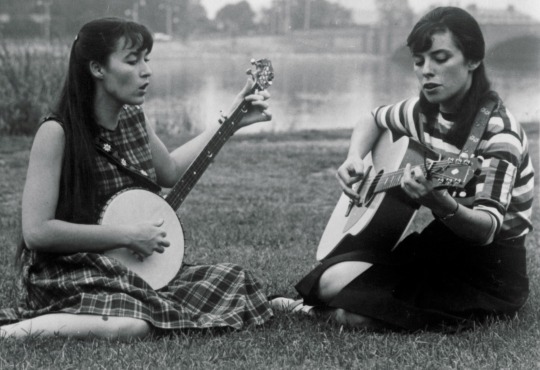
MORE BOB DYLAN IN BOSTON IN ‘63 MATERIAL PART TWO –>
First, read the Boston Globe story, then PART ONE, and then you can come back here, champ. ABOVE: Sally Schoenfeld and Joy Kimball, who are about to throw a very important party at their apartment in Cambridge, perform music together on the banks of the Charles River.
MORE on CAFE YANA
Originally on Beacon Street, Yana moved to 50 Brookline Ave after construction of the Mass Pike forced them to abandon their first address.
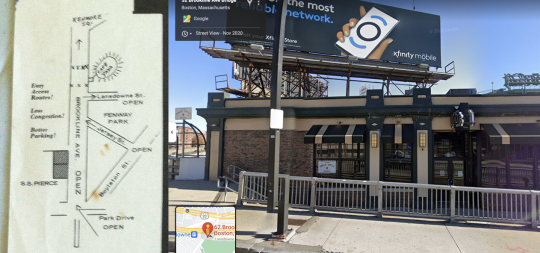
At some point, Yana’s space became swallowed up into one larger lot, 62 Brookline Ave, where Oliver’s Bar was located—which is the scene of one of the final post-Lou Velvet Underground shows and a very interesting Gram Parsons appearance where a fan gave GP some original lyrics which, incredibly, turned out to be “Return of the Grievious Angel.”
WAS SUZE THERE OR WHAT?
In Clinton Heylin’s latest Bob Dylan book, he writes of the Yana dates, “So where was Suze? She was supposed to meet her beau in Boston, having written to her displaced friend...earlier that month, ‘we’ll probably be in boston (cafe yana) april 19-20 (definitely, not probably).' And yet she was nowhere to be seen.”
But after talking to Yana waitress Susan Bluttman, and considering Suze’s letter to her friend Sue Zuckerman, I think it’s most likely the case that, at the very least, Suze was there for the Friday show at Cafe Yana. Bluttman was insistent her memory was correct and her recall of other verifiable details checked out. I specifically asked if it was just “some woman” with Dylan or definitely Suze. She had zero hesitation: she recalls welcoming the couple to the club and showing them where to go before showtime.
PAUL CLAYTON

Also on the bill with Dylan at Yana was New Bedford native, Paul Clayton, a fascinating person and a musician whose recorded catalog was already quite large by the time he met Bob; check out his album Bay State Ballads or Sailing and Whaling Songs of the 19th Century. Although Clayton approached folk from a scholarly, traditionalist point of view—watch for shades of Clayton in Justin Timberlake’s character in the Cohen Brothers film Inside Llewyn Davis—he also had a wild side with a penchant for drugs, partying, and rambling, and at times, Dylan embraced those predilections with him.
By all accounts, the pair had different kinds of infatuations with each other; Dylan saw Clayton as “traditional song personified, speaking to him in mystic tongues,” as Paul’s biographer Bob Coltman put it, and Clayton not only saw Dylan as the next step forward in folk music, but also a forbidden romantic desire. Many friends who saw the two interact instantly recognized Clayton’s massive crush on Dylan. "His biggest problem,” Clayton friend Patrick Sky told the Globe in 2013, “was that he was gay at a time when it was pretty much illegal.”
At the time of the Yana concerts, Dylan was about a month away from releasing Freewheelin’, including the future classic “Don’t Think Twice, It’s All Right,” which as it turned out, heavily borrowed its melody and many of its lyrics from Paul Clayton’s 1959 song “Who’s Gonna Buy You Ribbons,” which in turn had been based on "Who's Gon Bring You Chickens”—a tune Clayton found collected in a 1923 book titled Eight Negro Songs. It was a similar chain of influence as “Baby, Let Me Follow You Down” except that this time, Clayton’s song publishers would sue Dylan’s publisher over the lift. The matter was settled out of court, but Clayton’s continued poverty compared with Dylan’s steady success and accumulation of wealth did not go unnoticed by the Greenwich Village folkies who knew how it had all gone down. More and more, it seemed that it didn’t matter who actually wrote a particular song, but more who first obtained a copyright.

Dylan and Clayton’s time together was not quite finished yet, though it appears that the two nights at Café Yana were the final live bills they would ever share together as performers.
After one more druggy cross-country trip together, Clayton was placed outside of the inner circle without an explanation. There is one theory that Clayton began to date Suze’s sister Carla in to get closer to Bob, and when Bob’s relationship with Suze ended, it meant that Carla and Clayton also needed to go as well.
Everyone agreed that Dylan’s 1965 song “It’s All Over Now, Baby Blue” was some kind of send-off letter to the folk music world, but select listeners believed it to include specific references to Clayton, including, at times, Paul himself. Tragically, less than two years after Dylan “went electric” at the Newport Folk Festival, Clayton electrocuted himself in his own bathtub. When his personal belongings were cataloged, it was noted that he no longer owned an acoustic guitar, but kept an electric guitar and drums, as he was working on a strange experimental, electric suite of music titled “Gingerbreadd Mindd” which has never been released. Clayton is spoken about reverently in Dylan’s 2011 memoir, but his suicide is not mentioned.
JFK
The following day, Saturday April 20th, President John F. Kennedy spoke at Boston College. Still grappling with the fall out of the Cuban Missile Crisis, Kennedy kept the speech light and focused on the importance of the nation’s higher education system, opening his remarks by declaring “it is good to come back to a city where my accent is considered normal.” I only mention this because a) with Dylan’s late career 20-minute opus “Murder Most Foul” choosing Kennedy’s assassination as its anchor, it’s almost worth noting anytime the two were in relative close proximity to each other (like the same city). Additionally—and this is a longshot—would news of Kennedy in town specifically bring Dylan’s mind back towards the missile crisis, and thus World War III, and perhaps to the point of inspiration for writing “Talking World War III” blues? I have no idea. I’m just spit-ballin’ here.
NOV 2, 1963 @ JORDAN HALL - BLOWN IN THE WIND
Bob Dylan came back for another show in Boston in the fall, and this time, all the listings in the Globe and elsewhere spelled his name right, but unfortunately, they were still struggling with the exact song titles.
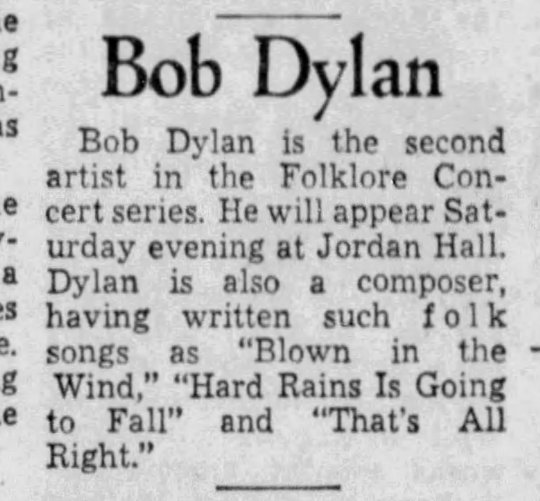
SYMPHONY HALL, FREAKING OUT DAVID LYNCH
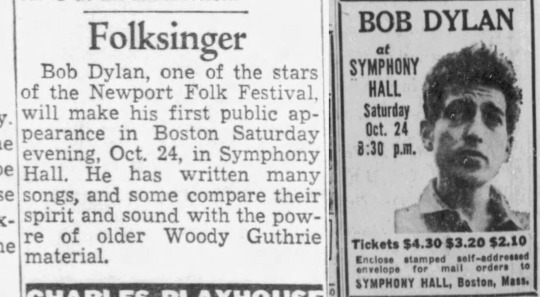
The following year, the Globe resets Dylan back to zero and claims his Symphony Hall show will be his first in the city. Oh well! In the audience at this show? Director David Lynch! Watch here.

More on Lynch living in Boston here. The Symphony Hall show setlist here.
JOAN BAEZ
This is a write-up and photo of Baez the night she headlined Donnelly Memorial Theater, Saturday April 20th, 1963, the night before the party in Cambridge where she and Dylan would finally crash into each other.

WAS MEL LYMAN AT THAT PARTY?
I don’t think so! I believe this all happens right before ol’ Mel rolls into town. From AW68 --->
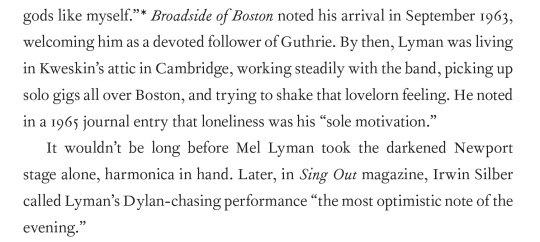
And finally, photos from the post-Hoot party, by Rick Stafford, as printed in the book Baby, Let Me Follow You Down.

That’s all for now. Thanks for reading!
1 note
·
View note
Link
The Double Life of Bob Dylan: A Restless, Hungry Feeling, 1941-1966 by Clinton Heylin https://amzn.to/3wkzHbh
https://bookshop.org/a/17891/9780316535212
#The Double Life of Bob Dylan: A Restless Hungry Feeling 1941-1966#Bob Dylan#Clinton Heylin#music#music books#music biography#biography books#biography#books#book review
19 notes
·
View notes
Link
Clinton Heylin weighs in.
5 notes
·
View notes

